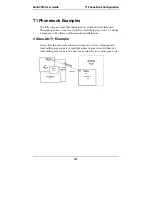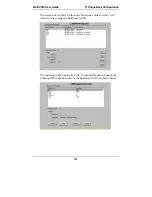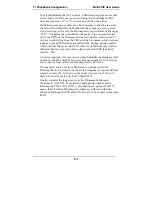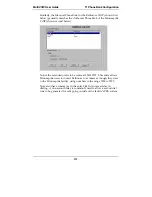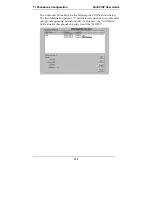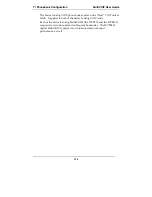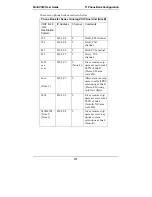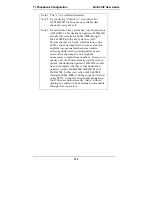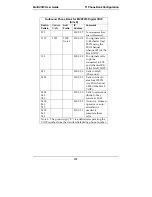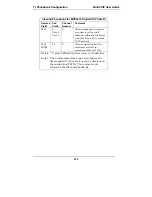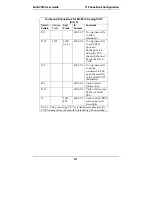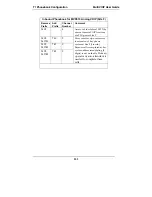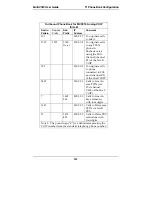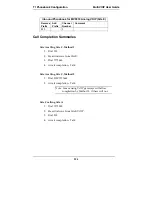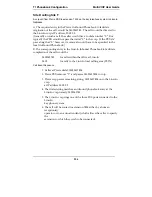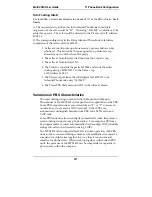
T1 Phonebook Configuration
MultiVOIP User Guide
192
To call the Minneapolis/St. Paul area, a Baltimore employee must dial
eleven digits. (In this case, we are assuming that the Baltimore PBX
does not require an “8” or “9” to seize an outside phone line.)
If a Baltimore employee dials any phone number in the 612 area code,
the call will automatically be handled by the company’s voip system.
Upon receiving such a call, the Minneapolis voip will remove the digits
“1612”. But before the suburban-Minneapolis voip can complete the
call to the PSTN of the Minneapolis local calling area, it must dial “9”
(to get an outside line from the PBX) and then a comma (which denotes
a pause to get a PSTN dial tone) and then the 10-digit phone number
which includes the area code (612 for the city of Minneapolis; which is
different than the area code of the suburb where the PBX is actually
located -- 763).
A similar sequence of events occurs when the Baltimore employee calls
number in the 651 and 952 area codes because number in both of these
area codes are local calls in the Minneapolis/St. Paul area.
The simplest case is a cal from Baltimore to a phone within the
Minneapolis/St. Paul area code where the company’s voip and PBX are
located, namely 763. In that case, that local voip removes 1763 and
dials 9 to direct the call to its local 7-digit PSTN.
Finally, consider the longest entry in the Minneapolis Inbound
Phonebook, “17637175. Note that the main phone number of the
Minneapolis PBX is 763-717-5170. The destination pattern 17637175
means that all calls to Minneapolis employees will stay within the
suburban Minneapolis PBX and will not reach or be carried on the local
PSTN.
Summary of Contents for MULTIVOIP MVP-3010
Page 6: ...6 Chapter 1 Overview ...
Page 28: ...28 Chapter 2 Quick Start Instructions ...
Page 38: ...Technical Configuration T1 E1 MultiVOIP User Guide 38 Chapter 4 Software Installation ...
Page 49: ...49 Chapter 5 Technical Configuration ...
Page 58: ...Technical Configuration MultiVOIP User Guide 58 Config Info CheckList ...
Page 117: ...MultiVOIP User Guide Technical Configuration 117 ...
Page 139: ...MultiVOIP User Guide Technical Configuration 139 ...
Page 170: ...170 Chapter 6 T1 Phonebook Configuration North American Telephony Standards ...
Page 184: ...T1 Phonebook Configuration MultiVOIP User Guide 184 3 Select Inbound PhoneBook List Entries ...
Page 208: ...208 Chapter 7 E1 Phonebook Configuration European Telephony Standards ...
Page 252: ...252 Chapter 8 Operation and Maintenance ...
Page 257: ...MultiVOIP User Guide Operation Maintenance 257 The Call Progress Details Screen ...
Page 265: ...MultiVOIP User Guide Operation Maintenance 265 The Logs Screen ...
Page 277: ...MultiVOIP User Guide Operation Maintenance 277 ...
Page 280: ...Operation and Maintenance MultiVOIP User Guide 280 T1 Statistics Screen ...
Page 288: ...Operation and Maintenance MultiVOIP User Guide 288 ...
Page 343: ...343 Chapter 9 Warranty Service and Tech Support ...
Page 347: ...347 Chapter 10 Regulatory Information ...
Page 352: ...352 Appendix A Cable Pinouts ...
Page 358: ...358 Appendix B TCP UDP Port Assignments ...
Page 360: ...360 Appendix C Installation Instructions for MVP428 Upgrade Card ...
Page 365: ...MultiVOIP User Guide Index 365 Index ...
Page 395: ...395 S000384A ...












